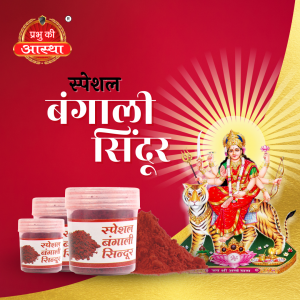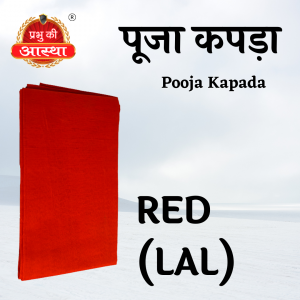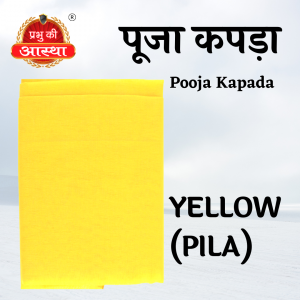PUJA ITEMS
-
 Read more
Read moreabir is often used to sprinkle over the deities and the offerings, or to mark the forehead of the devotees as a sign of blessing. The use of abir is believed to enhance the spiritual experience and create an atmosphere of joy and festivity. The various colors of abir also have specific meanings and associations in Hindu culture. For example, red is often used to symbolize love and passion, while yellow is associated with knowledge and wisdom. The use of abir is an important aspect of many Hindu festivals and ceremonies, such as Holi and Diwali, and is highly valued for its ability to enhance the spiritual and cultural significance of these occasions.
-
 Read more
Read moreHanuman Kumkum is a sacred and traditional red powder used in Hindu worship and rituals. It is made from a mixture of turmeric and slaked lime, which gives it a vibrant red color. Hanuman Kumkum is named after Lord Hanuman, the monkey god and ardent devotee of Lord Rama in Hindu mythology.
This kumkum is often applied on the forehead, between the eyebrows, as a symbol of respect and devotion to the deities. It is also used to adorn idols and pictures of Hindu gods and goddesses during puja or prayer ceremonies.
In addition to its religious significance, Hanuman Kumkum is believed to have several health benefits as well. It is said to have antiseptic properties and can be used to treat minor cuts and wounds. It is also believed to have a cooling effect on the skin and can help reduce inflammation.
Overall, Hanuman Kumkum is a significant part of Hindu culture and tradition, and it holds a special place in the hearts of devotees.
-
 Read more
Read moreBengali Sindur, also known as vermilion or sindoor, is a red-orange colored powder that is traditionally used by married women in Bengal as a symbol of their marital status. It is made by mixing turmeric and lime with mercury, which gives it its distinctive red-orange color. The sindur is applied by women on their hair parting and on the forehead, as a sign of their marriage and commitment to their spouse. The practice of applying sindur is considered to be auspicious and has deep cultural and religious significance in Bengali society. The sindur is also used in various religious rituals and ceremonies, and is often offered to deities as a symbol of devotion. However, it is important to note that due to the presence of mercury in traditional sindur, it can be harmful to health if ingested or applied in large amounts. As a result, many modern versions of sindur are now made without mercury, to ensure the safety of users.
-
 Read more
Read moreVibhuti Bhasmi is a sacred ash that is used in Hindu religious ceremonies, known as pujas. It is made by burning dried cow dung and ghee (clarified butter) in a fire, and then collecting the resulting ash. The ash is believed to have purifying and sacred properties and is used to make a tilak, which is a mark that is applied to the forehead as a sign of devotion and reverence to the deities. Vibhuti Bhasmi is also used in a variety of other religious practices, such as smearing it on the body or mixing it with water to create a sacred liquid. In addition to its use in religious ceremonies, Vibhuti Bhasmi is also used in Ayurvedic medicine for its various health benefits. It is believed to have antimicrobial and anti-inflammatory properties, and is used to treat a variety of health conditions, such as skin diseases and digestive issues. However, it is important to note that Vibhuti Bhasmi should only be used under the guidance of a healthcare professional, as it can be toxic if ingested or used improperly. Vibhuti Bhasmi remains an important part of Hindu culture and spirituality, and is widely used in religious and spiritual practices.
-
 Read more
Read moreSandalwood powder is a commonly used material in puja ceremonies in many Hindu traditions. It is derived from the wood of the sandalwood tree, which is native to southern India and is considered sacred. Sandalwood powder has a distinctive sweet, woody fragrance and a light, pale yellow color.
In puja ceremonies, sandalwood powder is often mixed with water to make a paste, which is then applied to the forehead or other parts of the body as a mark of auspiciousness. The paste is also used to make small mounds or shapes, known as chandanam, which are placed on the puja altar or offered to deities as a sign of devotion.
Sandalwood powder is believed to have many spiritual and medicinal benefits. It is said to promote tranquility, enhance concentration, and purify the mind and body. It is also believed to have antimicrobial properties and is used in Ayurvedic medicine to treat a variety of ailments.
Overall, sandalwood powder is an integral part of Hindu puja ceremonies and is valued for its aromatic, aesthetic, and spiritual qualities.
-
 Read more
Read moreGhee batti, also known as ghee diya, is a type of lamp used in Hindu religious ceremonies, particularly during puja or worship. It is made by melting ghee, which is clarified butter, and pouring it into a small clay or metal container with a cotton wick. The wick is lit and the ghee burns slowly,…
-
 Read more
Read moreIndian myrrh, also known as “guggul,” is a resin that is commonly used in Hindu religious ceremonies and pujas, particularly in North India. It is believed to have spiritual and medicinal properties, and is often used as an incense or offering during religious ceremonies.
In Hinduism, Indian myrrh is believed to have purifying and protective qualities, and is often used to ward off negative energies and evil spirits. It is also believed to have the ability to cleanse and purify the soul, and is used as an offering to the gods and goddesses.
In addition to its spiritual significance, Indian myrrh is also used in traditional Ayurvedic medicine to treat various ailments, including arthritis, skin disorders, and digestive issues. It is believed to have anti-inflammatory and antimicrobial properties, and is commonly used in Ayurvedic remedies and supplements.
When using Indian myrrh for puja or religious ceremonies, it is important to ensure that you are using high-quality, pure resin from a trusted source. It is also important to follow proper safety precautions, such as using a heat-resistant container and avoiding inhalation of the smoke.
Overall, Indian myrrh is a valued and versatile ingredient in Hindu religious ceremonies and traditional medicine, and is still widely used today for its spiritual and medicinal properties.
-
 Read more
Read moreGulal is a type of colored powder that is commonly used in Hindu religious ceremonies and pujas, particularly during the festival of Holi. It is made from natural ingredients such as cornstarch, flour, and natural pigments, and is available in a wide range of colors.
In Hinduism, gulal is used as an offering and a symbol of devotion, and is often thrown or smeared on the faces and clothes of other devotees as a sign of celebration and camaraderie. It is also used to decorate homes, temples, and other sacred spaces during religious ceremonies.
In addition to its religious and cultural significance, gulal is also believed to have medicinal properties. It is often used in traditional Ayurvedic medicine to treat various ailments, including skin disorders, digestive issues, and respiratory problems. Some types of gulal are also believed to have insect-repelling properties.
When using gulal for puja or religious ceremonies, it is important to ensure that you are using high-quality, natural, and non-toxic gulal from a trusted source. It is also important to follow proper hygiene and safety precautions, such as avoiding contact with the eyes and mouth, and avoiding inhalation of the powder.
Overall, gulal is a vibrant and meaningful part of Hindu religious ceremonies and festivals, and is still widely used today for its cultural, spiritual, and medicinal properties.
-
 Read more
Read moreIn Hinduism, the tortoise is considered to be a symbol of stability, longevity, and perseverance. It is also associated with Lord Vishnu, one of the most important deities in Hinduism. Therefore, tortoise shells are often used in Hindu puja rituals and ceremonies. The tortoise shell is considered to be a sacred and powerful object in…
-
 Read more
Read morePuja Kapada, also known as puja cloth or altar cloth, is an essential part of Hindu puja ceremonies. It is a piece of cloth used to cover the altar or the puja space during the ceremony.
Puja Kapada is made of different materials, including cotton, silk, and satin, and is available in various colors and designs. The choice of material and color may vary depending on the deity being worshipped, the occasion, or personal preference.
During puja ceremonies, Puja Kapada is used to cover the altar or the puja space to create a sacred and pure environment. It is believed to protect the deities being worshipped from negative energies and bring blessings to the devotees.
Puja Kapada is also used to cover the offerings made during the puja ceremony, such as flowers, fruits, and sweets. It is believed to enhance the purity and sanctity of the offerings and prevent them from being contaminated.
In addition to its use in puja ceremonies, Puja Kapada is also used as a gift or offering to the deities or the temple. It is considered a symbol of devotion and respect towards the divine.
In conclusion, Puja Kapada is an essential part of Hindu puja ceremonies and is used to create a sacred and pure environment. Its use enhances the purity and sanctity of the offerings and protects the deities from negative energies. Moreover, it is considered a symbol of devotion and respect towards the divine and is used as an offering or gift in Hindu culture.
-
 Read more
Read morePuja Kapada, also known as puja cloth or altar cloth, is an essential part of Hindu puja ceremonies. It is a piece of cloth used to cover the altar or the puja space during the ceremony.
Puja Kapada is made of different materials, including cotton, silk, and satin, and is available in various colors and designs. The choice of material and color may vary depending on the deity being worshipped, the occasion, or personal preference.
During puja ceremonies, Puja Kapada is used to cover the altar or the puja space to create a sacred and pure environment. It is believed to protect the deities being worshipped from negative energies and bring blessings to the devotees.
Puja Kapada is also used to cover the offerings made during the puja ceremony, such as flowers, fruits, and sweets. It is believed to enhance the purity and sanctity of the offerings and prevent them from being contaminated.
In addition to its use in puja ceremonies, Puja Kapada is also used as a gift or offering to the deities or the temple. It is considered a symbol of devotion and respect towards the divine.
In conclusion, Puja Kapada is an essential part of Hindu puja ceremonies and is used to create a sacred and pure environment. Its use enhances the purity and sanctity of the offerings and protects the deities from negative energies. Moreover, it is considered a symbol of devotion and respect towards the divine and is used as an offering or gift in Hindu culture.
-
 Read more
Read morePuja Kapada, also known as puja cloth or altar cloth, is an essential part of Hindu puja ceremonies. It is a piece of cloth used to cover the altar or the puja space during the ceremony.
Puja Kapada is made of different materials, including cotton, silk, and satin, and is available in various colors and designs. The choice of material and color may vary depending on the deity being worshipped, the occasion, or personal preference.
During puja ceremonies, Puja Kapada is used to cover the altar or the puja space to create a sacred and pure environment. It is believed to protect the deities being worshipped from negative energies and bring blessings to the devotees.
Puja Kapada is also used to cover the offerings made during the puja ceremony, such as flowers, fruits, and sweets. It is believed to enhance the purity and sanctity of the offerings and prevent them from being contaminated.
In addition to its use in puja ceremonies, Puja Kapada is also used as a gift or offering to the deities or the temple. It is considered a symbol of devotion and respect towards the divine.
In conclusion, Puja Kapada is an essential part of Hindu puja ceremonies and is used to create a sacred and pure environment. Its use enhances the purity and sanctity of the offerings and protects the deities from negative energies. Moreover, it is considered a symbol of devotion and respect towards the divine and is used as an offering or gift in Hindu culture.

